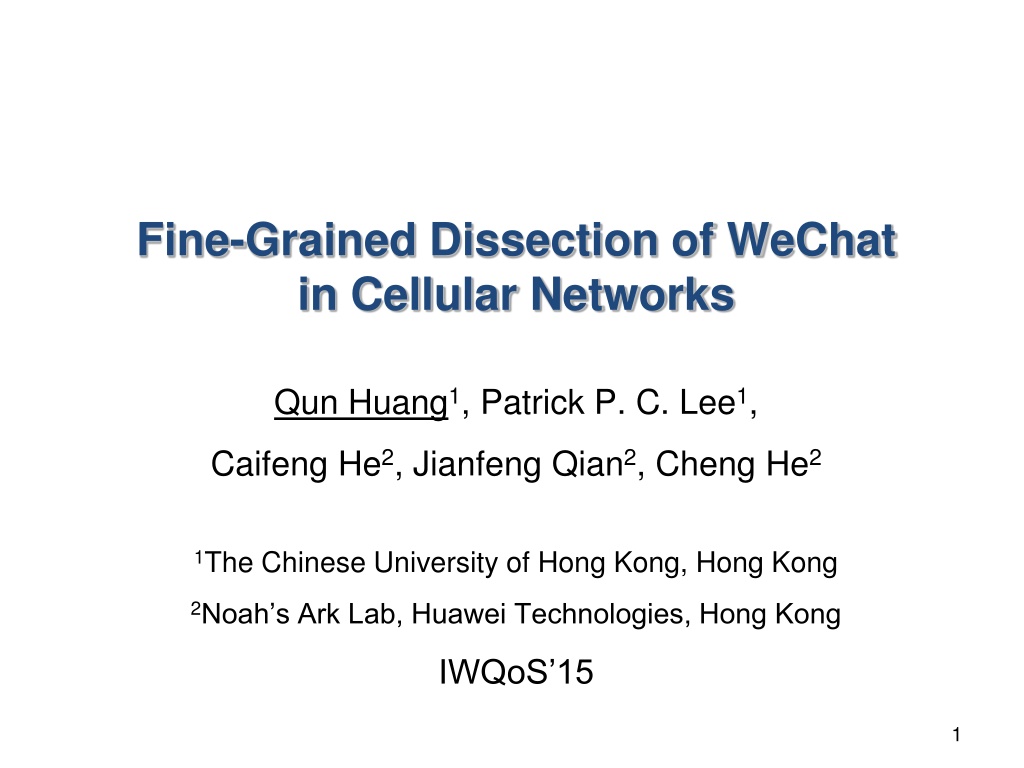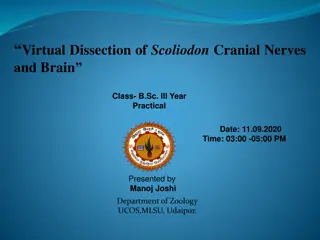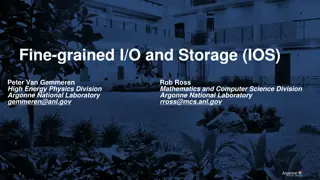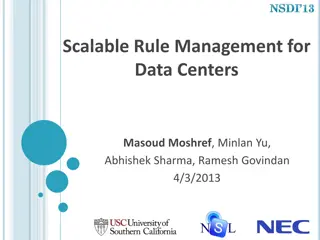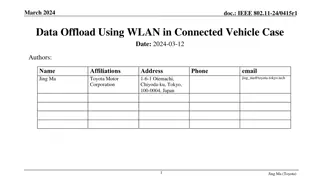Fine-Grained Dissection of WeChat in Cellular Networks
This study focuses on analyzing the traffic characteristics of WeChat, a popular mobile application, through a methodology called ChatDissect. The research delves into identifying message formats and semantics, distinguishing user behavior, and classifying traffic functionalities. Challenges in measuring WeChat traffic are addressed, and the study aims to unveil the architecture and functionality workflows of WeChat. Control experiments were conducted using a variety of devices and network setups to capture and analyze real-world traffic dynamics.
Download Presentation

Please find below an Image/Link to download the presentation.
The content on the website is provided AS IS for your information and personal use only. It may not be sold, licensed, or shared on other websites without obtaining consent from the author. Download presentation by click this link. If you encounter any issues during the download, it is possible that the publisher has removed the file from their server.
E N D
Presentation Transcript
Fine-Grained Dissection of WeChat in Cellular Networks Qun Huang1, Patrick P. C. Lee1, Caifeng He2, Jianfeng Qian2, Cheng He2 1The Chinese University of Hong Kong, Hong Kong 2Noah s Ark Lab, Huawei Technologies, Hong Kong IWQoS 15 1
Motivation WeChat: one of the most popular mobile applications By August 2014, 432 million users, including 100 million outside China 50% media resource sharing among social networks in China WeChat functionalities Instant messaging text, images, voice, video Real-time chatting full-duplex VoIP half-duplex walkie-talkie Moment (sharing platform) Posts, photos, other resources from Internet Media access E.g. subscription articles It is interesting to characterize WeChat traffic 2
Challenges for WeChat Measurement Real-world traffic Mix of a large number of applications WeChat traffic Mix of WeChat functionalities No knowledge on WeChat WeChat protocol specifications are proprietary It is infeasible to Distinguish WeChat traffic from real-world traces Classify WeChat traffic into functionalities 3
Our Contribution ChatDissect: infer both format and semantics of WeChat messages Measurement study based on the inference results Distinguish 150K WeChat users and 16GB WeChat traffic from real-world network traces Classify distinguished traffic into functionalities Unveil WeChat architecture and functionality workflows Characterize traffic dynamics To our best knowledge, this is the first and the only published study on real-world WeChat traffic 4
Architecture Control Control Experiments Experiments Feedback Training Set Extract Extract Signatures Signatures WeChat Signatures Architecture Classify Classify Traffic Traffic Workflow Real-world Traces Traffic dynamics 5
Control Experiments: Approach WeChat Servers Smartphones Private wireless network Public Internet Captured Traces Different setup Smartphones: Android and iPhone WeChat client versions: 4.5 and 5.0 Noisy handling Disable all other foreground applications Manually examine and eliminate unwanted traffic in the captured traces We perform 16 functionalities, each repeated several times 6
Control Experiments: Results 22K IP packets with 12MB payload volume Comprises 4 types of traffic WeChat traffic DNS HTTP Non-DNS UDP Non-HTTP TCP Long flows Short flows Many small and short flows Used by most tasks Used by most tasks One or two large flows Each flow includes multiple tasks For real-time chatting We refer to them as W-DNS, W-HTTP, W-UDP and W-TCP, respectively 7
Outline Control Control Experiments Experiments Feedback Training Set Extract Extract Signatures Signatures WeChat Signatures Architecture Classify Classify Traffic Traffic Workflow Network Traces Traffic dynamics 8
Signature Definition WeChat payload signatures format and semantics of WeChat message protocol Network protocol format A sequence of fields Fields have different length Each field is defined with a set of values Network protocol semantics meaning of fields and their values 9
Methodologies WeChat traffic comprises four types No unified methodology for all types WeChat traffic W-DNS W-HTTP W-UDP W-TCP Documentations are available No documentations Parse and inspect fields directly Inference protocol format and semantics We do not propose new techniques, but combine existing techniques to extract signatures. 10
Extract Signatures for W-DNS and W-HTTP Challenges: enormous fields Payload W-DNS W-HTTP Field Selection Hostnames Hostnames, Method, URL, Referer, User-Agent Representative fields Keyword Extraction Extract values for each field Based on longest common substring approach [Ma et al. 2006, Tongaonkar et al. 2013] {Field: values} Output Signatures 11
Extract Signatures for W-UDP and W-TCP Payload segmentation Extent ProWord [Zhang et al. 2014] Iteratively execute the Voting Experts algorithm [Cohen and Adams 2001] Address packet fragmentation issue in W-TCP Field 1: offset, length, values Field 2: offset, length, values Consider 5 field types For each type, propose a heuristic to determine whether a field belongs to the type Field 1: type Field 2: type WeChat Payloads Payload Segmentation Field type inference Field Type Inference Constant, seq number, length, req./res., opcode Opcode correlation Employ 3 techniques for the correlation Inspect traces in control experiments Reverse-engineer Android APK package Check co-occurrence with other known tasks Opcode correlation Mapping: 12 {Opcode value -> Task}
Classify Traffic & Feedback Traffic classification Step 1: group packets into flows Step 2: categorize flows into DNS, HTTP, Non-DNS UDP and Non-HTTP TCP Step 3: match payloads with signatures Feedback Motivation Control experiments only cover partial signatures Approach: for each classified WeChat flow Identify all unclassified flows with the same server-side IP and port Apply the same extraction procedure to the feedback traffic We may need multiple rounds of feedback Our experience: feedback once is sufficient 13
Outline Control Control Experiments Experiments Feedback Training Set Extract Extract Signatures Signatures WeChat Signatures Architecture Classify Classify Traffic Traffic Workflow Network Traces Traffic dynamics 14
Results: Payload Signatures W-DNS Hostname (WeChat aliases) W-HTTP Hostname Referer User-Agent weixin.qq.com wx.qq.com weixin wechat MicroMessenger Method and URL indicate functionalities Post method Most WeChat tasks Third-party resources Get method WeChat-specific resources W-UDP 4 message types All for real-time chatting (Content, heartbeats, signaling) W-TCP: persistent flows for most WeChat tasks 0 4 8 11 12 Request / Response O P Sequence Number Constant Length We identify the functionalities for 126 opcodes 15
Results: Service Architecture WeChat architecture comprises a set of clusters Each for one group of functionalities 16
Results: Workflow Most WeChat tasks completed by W-TCP to long servers, Or W-HTTP to short servers Real-time chatting Three phases Resource access completed by W-HTTP GET to servers directly, Or W-HTTP POST to replay requests 17
Results: Traffic Dynamics We identify 150K WeChat users and 16GB WeChat traffic Account for 50% of total users and 9% of total traffic volume We measure traffic dynamics, including User activities Functionality usage Flow characteristics 18
Results: Main Findings Enormous users, but most are quiet WeChat accounts for 50% of total users Most users keep online, but only transfer a few traffic Downlink traffic has much higher volume than uplink traffic Nearly 91% traffic are downlink Most tasks are completed using either W-HTTP and W- TCP W-TCP has better user experience W-TCP introduces heartbeat messages to keep flows persistent We will measure more results on larger traces in the future. 19
Conclusions Propose ChatDissect, a tool to infer message formats of network protocols Present payload signatures for various types of WeChat traffic Unveil the core architecture and workflows of WeChat tasks Identify 150K WeChat users and 16GB WeChat traffic Measure user activities, functionality usage, flow characteristics of real-world WeChat traffic 20
